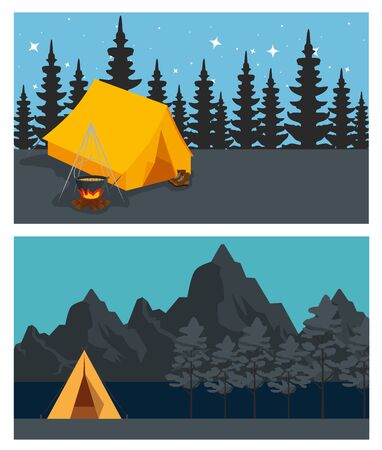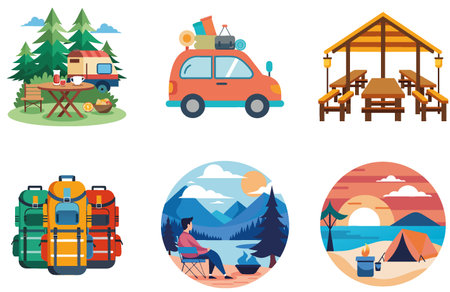Introduction: Why Smart Packing Matters for Kid Safety
Camping with kids is an adventure that promises lasting memories, but it also comes with serious responsibilities—especially when it comes to safety. Smart parents know that careful preparation is the foundation of a fun and secure outdoor experience. Packing the right camp gear isn’t just about comfort or convenience; it’s about anticipating risks and making proactive choices that protect your child in unpredictable environments. From sudden weather changes to unexpected scrapes and stings, having the correct equipment on hand can make all the difference. This guide will help you focus your packing list on safety essentials, giving you peace of mind and empowering your family to fully enjoy every moment under the open sky.
Essential Shelter and Sleep Gear
When it comes to camping with kids, a safe and cozy sleeping setup is non-negotiable. The right shelter and sleep gear not only ensure your childs comfort but also provide essential protection from the elements and nighttime critters. Let’s break down what you need to keep your little ones secure through the night.
Kid-Friendly Tents: Features That Matter
Childrens tents should be more than just smaller versions of adult tents. Look for features that cater specifically to safety, comfort, and ease of use. Heres a quick comparison:
| Tent Feature | Why It Matters | Recommended Options |
|---|---|---|
| Easy Setup | Saves time and reduces frustration, especially with impatient kids. | Pop-up or color-coded pole systems |
| Ventilation | Prevents stuffiness and keeps air fresh inside the tent. | Mesh windows, vents with covers |
| Bug Protection | Keeps mosquitoes and other insects out while letting air in. | No-see-um mesh netting |
| Weatherproofing | Protects from rain, wind, and morning dew. | Taped seams, bathtub floors, rainfly included |
| Child-Safe Zippers | Prevents pinched fingers and accidental openings. | Zipper covers or easy-grip pulls |
Choosing the Right Sleeping Bag for Kids
A good night’s sleep starts with a sleeping bag that fits. Adult-sized bags are often too big, leaving room for cold spots. Instead, pick one designed for kids—these are usually shorter, have snug hoods, and sometimes even come in fun colors or patterns to make bedtime exciting. Check the temperature rating to match your camping season (for most U.S. summer trips, a 30–40°F bag is ideal).
Sleeping Bag Checklist:
- Proper Fit: Shouldnt be too roomy—kids lose body heat faster than adults.
- Synthetic Insulation: Warms even if damp and dries quickly (down is lighter but loses warmth when wet).
- Mummy Shape: Offers better warmth for little bodies compared to rectangular shapes.
- Kid-Proof Zippers: Easy-open zippers prevent midnight frustration.
- Pillow Pocket: Some bags have built-in pockets for stashing a favorite pillow or stuffed animal.
Nighttime Essentials for Security and Comfort
| Item | Description & Safety Tip |
|---|---|
| Cot or Sleeping Pad | Adds insulation from cold ground; choose non-slip surfaces to prevent rolling off. |
| Kiddie Headlamp/Flashlight | Eases nighttime fears; opt for models with adjustable brightness and soft straps. |
| Nite Light/Glow Stick | Provides gentle light so children can find their way or signal for help if needed. |
| Comfort Object (Stuffed Animal/Blanket) | A familiar item helps soothe anxiety in a new environment. |
| Mosquito Netting (if not built-in) | Adds an extra layer of bug protection around the sleep area. |
| Earmuffs or Earplugs (Optional) | If your child is sensitive to outdoor noises at night. |
Your Takeaway as a Smart Parent:
Packing the right shelter and sleep gear isn’t just about getting through the night—it’s about making camp feel like a safe home base for your kids. Prioritize quality over quantity, test gear at home before you go, and always involve your child in the setup process so they know their space is secure. With these essentials covered, you’ll lay the groundwork for restful nights and happy campers all trip long.

3. Clothing and Weather Protection
When it comes to camp gear for kid safety, nothing beats being prepared for whatever the weather throws your way. Outfitting your child with the right clothing layers is crucial—not just for comfort, but for health and safety too. Start with moisture-wicking base layers that help keep sweat off your childs skin. Add a mid-layer like a fleece or lightweight insulated jacket for warmth, and top it off with a waterproof, breathable shell. American summer camps can experience everything from blazing sun to sudden rainstorms, so packing versatile options is key.
Sun Protection Essentials
Never underestimate the sun’s power, especially in open fields or near water. Pack UPF-rated long-sleeve shirts, wide-brim hats, and polarized sunglasses to shield delicate skin and eyes from UV rays. Don’t forget broad-spectrum sunscreen (SPF 30+), lip balm with SPF, and remind kids to reapply every two hours—especially after swimming or sweating.
Rain Gear Must-Haves
Rain can strike unexpectedly during campouts or hikes. Equip your child with a quality rain jacket featuring sealed seams and adjustable hoods. Lightweight rain pants and waterproof boots are smart additions, ensuring your camper stays dry and warm even if puddles are irresistible.
Tips for Changing Conditions
Weather can shift fast, so teach kids how to layer up or down as temperatures change throughout the day. Label all clothing clearly to prevent mix-ups at camp. Consider quick-dry materials for socks and shirts—wet cotton can quickly turn a fun day into an uncomfortable one. Always pack an extra set of clothes in a zip-top bag for emergencies. With these tips, you’ll help your child stay safe, comfortable, and ready for every adventure nature brings.
4. Health and Hygiene Must-Haves
When it comes to camping with kids, staying healthy and clean is just as important as having fun. Smart parents know that being prepared for the unexpected can make all the difference in keeping little campers safe and happy. Here’s a breakdown of essential health and hygiene items every family should pack:
First Aid Kit Essentials
A well-stocked first aid kit is non-negotiable for any camping trip. Accidents happen, whether it’s a scraped knee or a bug bite. Pack a kit that covers basics and beyond, including kid-friendly medications. Here’s what you’ll want on hand:
| Item | Purpose |
|---|---|
| Bandages (various sizes) | Cover cuts and scrapes |
| Antiseptic wipes/cream | Clean wounds, prevent infection |
| Tweezers | Remove splinters or ticks |
| Pain reliever (kids’ formula) | Manage headaches, fevers |
| Allergy medication (antihistamine) | Treat allergic reactions, stings |
| Gauze pads and tape | Dress larger wounds |
Insect Repellent & Bite Relief
Bugs can be more than annoying; they can ruin the camping experience or even carry diseases. Choose an EPA-approved insect repellent suitable for kids and don’t forget after-bite treatment sticks or creams to soothe any itchy spots.
Sun Protection Must-Haves
- Broad-spectrum sunblock (SPF 30+), water-resistant, designed for sensitive skin or children
- Lip balm with SPF protection
- Sunglasses with UV protection (fit your child’s face snugly)
Other Health-Centric Gear
- Hand sanitizer for quick cleaning before meals and after bathroom breaks
- Biodegradable soap and washcloths for easy campsite hygiene
- Travel-size tissues and baby wipes—versatile for sticky hands or messy faces
Pro Tip: Label your health gear with your child’s name to avoid mix-ups at group campsites.
By organizing these essentials ahead of time, you’ll help prevent common camping issues like sunburns, bug bites, minor injuries, and tummy bugs—so everyone can focus on making great outdoor memories.
5. Navigation and Communication Tools
When it comes to camp safety, making sure your child can stay oriented and connected is just as important as packing the right clothes or bedding. Smart parents know that navigation and communication tools arent just for emergencies—they also help build kids’ confidence and independence in new environments. Here’s how you can equip your child with age-appropriate gear that keeps them safe and gives you peace of mind.
Whistles: A Simple Signal for Help
A sturdy whistle is one of the most effective tools for younger campers. Teach your child to wear their whistle around their neck or attach it to their backpack, and explain the “three blasts” rule—a widely recognized signal for help in American campsites and parks. Practice at home so your child knows when and how to use it responsibly.
Walkie-Talkies: Staying in Touch Made Fun
For older kids who are ready for a bit more responsibility, walkie-talkies are a game-changer. Choose models with good range (usually up to 2 miles in open areas) and simple controls. Set clear ground rules: check-in times, designated channels, and reminders about privacy. Using walkie-talkies not only helps your child feel secure but also adds an element of fun to exploring the outdoors.
ID Bracelets: Essential Info at Their Fingertips
Accidents happen—even on well-organized trips. An ID bracelet with your child’s name, emergency contact info, allergies, or medical needs can speak for them if they ever get separated from the group. Opt for waterproof and durable options that won’t irritate young skin. Many American parents find these bracelets especially reassuring during overnight or multi-day camps where staff changes might occur.
Age-Appropriate Gear Tips
- Younger Kids (Ages 5-8): Stick with whistles and simple ID tags—avoid tech-heavy gadgets that can be distracting or confusing.
- Older Kids (Ages 9-12): Add walkie-talkies, laminated map cards of the campgrounds, or even basic compasses for orientation practice.
Pro Tip:
Before camp starts, role-play scenarios where your child might need to use their safety gear. Familiarity builds confidence—and confident kids are safer campers!
6. Food and Hydration Safety
Safe Water Bottles: Hydration Without Worries
Keeping your kids hydrated at camp is a top priority, but not all water bottles are created equal. Look for BPA-free, leak-proof bottles that are easy for small hands to open and close. Insulated stainless steel bottles are a smart investment—they keep drinks cool during hot summer days and won’t shatter if dropped. Labeling each bottle with your child’s name helps avoid mix-ups and the spread of germs. If you’re heading somewhere with questionable water sources, consider packing a portable water filter or purification tablets as an extra layer of protection.
Healthy Snacks: Energy Boosts on the Go
Kids burn a lot of energy outdoors, so having nutritious, non-perishable snacks on hand is essential. Choose trail mixes without candy, whole grain crackers, nut butter packets (if allergies aren’t an issue), and dried fruit. These options provide sustained energy and don’t spoil quickly in the heat. Pre-portion snacks into resealable bags or containers to make them easy for kids to grab—and to reduce waste at the campsite. Avoid snacks that melt easily or attract wildlife, like chocolate or overly sweet treats.
Food Storage Solutions: Keeping Wildlife Out and Food Fresh
Proper food storage isn’t just about freshness—it’s also about safety from curious critters. Invest in bear-proof containers or lockable hard-sided coolers if you’ll be camping in areas known for wildlife activity. For less wild settings, airtight plastic bins can help deter raccoons and squirrels while keeping food organized. Always store food away from sleeping areas, preferably hung from a tree or locked in a vehicle at night. Teach your kids why it’s important not to leave snacks out; this helps reinforce safe habits for future camping adventures.
Smart Parent Tip:
Before you go, involve your kids in packing their own snack kits and water bottles. This gives them ownership over their health and teaches responsibility—plus, they’re more likely to eat what they helped pick out!
7. Campground Safety Extras
When it comes to camping with kids, a little extra preparation goes a long way. Beyond the basics, smart parents know that having bonus safety gear can make all the difference for peace of mind. Here are some campground safety extras you’ll want to consider packing for your next family adventure:
Headlamps and Personal Lights
Evenings at the campsite can get dark fast, especially in the woods or during unexpected power outages. Equip each child with their own headlamp or wearable LED light. Not only does this help them see where they’re going, but it also makes it easier for you to keep an eye on them as dusk falls.
Child Locator Devices
No parent wants to imagine their child wandering off, but being prepared is key. Modern child locator devices—like GPS-enabled wristbands or clip-on trackers—let you monitor your child’s location through your smartphone. These gadgets are especially useful in busy campgrounds or when exploring new trails.
Fire Safety Equipment
Campfires are a classic part of the camping experience, but they can be risky with curious kids around. Pack a small fire extinguisher or fire blanket and make sure it’s easily accessible near your campsite’s fire pit. Teach children about fire safety and establish clear boundaries around the campfire area.
First Aid Kit Upgrades
Your standard first aid kit should always come along, but consider adding extras like instant cold packs, children’s insect bite cream, and brightly colored bandages that appeal to kids (and encourage them to speak up about minor injuries).
Pro Tip for Parents
If your kids have allergies or specific medical needs, pack an emergency info card in their backpacks or pockets. Include your contact info, relevant medical details, and any allergy action plans.
Peace of Mind Means More Fun
Packing these campground safety extras may take a few more minutes, but you’ll thank yourself later. With the right gear in place, you can focus on making memories and enjoying the great outdoors—knowing your kids are safe every step of the way.


